#apartment belgrade
Explore tagged Tumblr posts
Text
Atelje 212-Četvoroiposoban stan sa prostranom terasom
Prodaja četvoroiposobnog stana u strogom centru Beograda
Stari grad, Svetogorska, Četvoroiposoban, 100m2 podne površine, 75m2 redukovane + 25m terasa, 5/5 st, eg, dva mokra čvora, uknjižen na 75m2. Izuzetno funkcionalan stan, nastao nadziđivanjem 1995 godine postojeće predratne zgrade, dvostrane orijenacije, delimično pod blagim kosinama i sa krovnim prozorima. Iz prostranog dnevnog boravka se pristupa uređenoj terasi. Iznad stana je kosi krov.…
#apartment belgrade#atelje 212#cetvoroiposoban#nekretnine#penthouse#prodaja stanova u beogradu#STANOVI#strogi centar#svetogorska#trg republike#uknjizeni stanovi
0 notes
Text




Serbia (2) (3) (4) by benbeiske
#buildings#golden light#dim light#roaming the streets#people#city life#apartment buildings#churches#serbia#belgrade
14 notes
·
View notes
Text

Turks and Caicos vacation villa by owner
https://www.opulenceestate.com/about-us.php
#TCI Providenciales group vacation homes#luxury vacation condo rentals Toronto#1 bedroom vacation apartment Belgrade#Turks and Caicos vacation villa for rent
0 notes
Text

Anti-cop sign seen in Belgrade, Serbia during the protest demanding justice for two young LGBTQ+ people who were humiliated, sexualy assaulted and tortured for hours by the police during the raid on their apartment
299 notes
·
View notes
Text
Belgrade Palace, better known as "Beogradjanka" is a business building completed in 1974. Its design features more glass, setting it apart from the brutal concrete architecture typical of the 1970s.

47 notes
·
View notes
Photo
I can do Better

I saw these two pictures on a Tumblr feed of Belgrade, Serbia I’m always interest in how HVAC is installed and serviced in other countries. #belgradeserbia #belgrade #serbia #apartment #belgradephoto #travel #hvac #airconditioning #ductless #hvaclove #hvacservice #hvaclife (at Belgrade, Serbia)
#belgradephoto#hvacservice#belgrade#hvaclife#travel#serbia#airconditioning#ductless#apartment#hvac#belgradeserbia#hvaclove
1 note
·
View note
Text
Yugoslavia and yugo rock

Joker Out’s new song, Šta bih ja, was inspired by yugorock! Not sure what that means? JokerOutSubs has got you!
‘Yugo rock’ or ‘Yu rock’ is rock with some elements derived from traditional/ethnic/folklore music, as well as other musical genres, including blues, country, reggae, jazz rock and rockabilly. They were added to appease the public, since rock itself was considered a western influence.
Rock music in Yugoslavia became popular in the sixties. Before that, after the second world war, partisan songs were more popular. This is music associated with resistance groups that fought German occupation across Yugoslavia, Italy and other parts of Eastern Europe. However, in 1956, the Cominform (a coordinated body of communist parties across Europe, designed to keep all communist governments following Stalinist principles) was dissolved. After this point, the connection with the Soviet Union was severed and music tastes began to change accordingly.
With influences from the west, rock music started gaining popularity. At first, musicians only sang covers of foreign songs (as closely to the original as possible) but in the sixties, bands such as Indexi started making original music. In the seventies, Bijelo dugme were formed and became incredibly popular. At the same time, Parni valjak were also rising to fame. However, the ‘new wave’ of Yugo rock was said to be started by a group called Buldožer.
Some characteristics of New Wave were more political lyrics and taking inspiration from punk. The most famous New Wave bands in Yugoslavia were Azra, Idoli, Prljavo kazalište, Električni orgazam, Psihomodo pop and, in Slovenia at the time, Lačni Franz, Buldožer and Pankrti (an interview with their singer Peter Lovšin can be found at • [ENG SUB] Bojan Cvjetićanin about roc... ).
A second New Wave generation from Belgrade emerged in later years. Among their representatives were Partibrejkers (formed 1982). They combined the blues with British R and B, rockabilly and classic rock and roll.
In 1982, the groups Ekaterina Velika and Disciplina Kičme (Disciplin A Kitschme) were established, contributing to the second New Wave generation, along with Slovenian group Videosex (formed 1983) with singer Anja Rupel. One of their most famous songs, a cover of 'Zemlja pleše,' can be found at • Videosex - Zemlja Plese - The Original
The New Wave was characterised by a burst of creativity and activity in the music scene across the region, with many artists emerging and creating excellent music in a short period of time. Many have drawn parallels between the New Wave era and today, where in Slovenia many young bands are gaining recognition. This parallel is only strengthened by the fact that Joker Out, one of the most successful young bands in Slovenia today, have a song named Novi val (New Wave).
The socio-political significance
Yugoslavia (1918–1992), a federal republic, was made up of six republics (Bosnia and Herzegovina, Croatia, Macedonia, Montenegro, Serbia, and Slovenia). Despite the differences between the republics one could argue that the pop-cultural identity was so strong, having influence that went beyond government control and the ability to connect people through the region, that it could be named as the seventh republic. Besides sport, yugorock was one of the last connecting links within a country that was drifting apart in a variety of areas, including economic.
Important yugorock bands
Bijelo Dugme: Considered by many to be the biggest Yugo rock band, Bijelo Dugme were formed in 1974 in Sarajevo. They were the biggest trendsetters in rock music at the time. They had a huge influence on Joker Out since their earliest days as a band. In the 'Kofi brejk' interview Bojan shared that the first concert he ever attended was by Bijelo Dugme, and they were also mentioned several times by Joker Out as having had a big influence on the whole band. In addition, Joker Out covered two of their songs, ‘Selma’ (Radio Koper, 32 min) and ‘Djurdjevdan’ (Belgrade concert, 3.11.2023). You can check out some more of their songs on our playlist linked at the bottom of this post!
Plavi orkestar were formed in 1983 in Sarajevo and had a rich career with eight albums, releasing hits such as ‘Ako su to samo bile laži’, ‘Lovac i košuta’, ‘Odlazim’, ‘Bolje biti pijan nego star’, ‘Suada’ and many more. Some media outlets, like Jutarnji list and Mladina have compared Joker Out’s style to theirs, and Bojan also mentioned Plavi orkestar as one of the bands that influenced him.
Parni valjak are a Croatian band, formed in 1975 in Zagreb. They had many ‘evergreen’ hits, including ‘Sve još miriše na nju’, ‘Jesen u meni’ and ‘Zastave’. In the Carpe Diem series, when asked whom they would listen to forever if they could only choose one artist, Jure chose Parni valjak. At Arsenal Fest in 2023, Bojan interrupted an interview to sing along to ‘Jesen u meni’ as they were playing in the background!
Indexi were a Bosnian band, who were active from 1962 to 2001. They were extremely influential, with hits like ‘Svijet u kome živim’ and ‘Negdje u kraju, u zatišju’, and became known as the ‘pioneers of psychedelic rock and roll.’ In the Kurir interview, Bojan mentions them as one of his musical role models.
Ekatarina velika, sometimes shortened to EKV, were a Serbian band who were active between 1982 and 1994. They are considered one of the most influential artists in the yugorock scene, with popular songs like ‘Krug’, ‘Par godina na nas’ and ‘Srce’. In the Rdeče in črno interview, Bojan’s voice was compared to that of the lead singer in Ekatarina velika.
Idoli were one of the most remarkable new wave bands based in Belgrade, active during the early 80's. They are regarded as one of the most outstanding and influential representatives of the Yugoslav rock music and their album 'Odbrana i poslednji dani' ('Defense and The Last Days') was voted as the greatest Yugoslav rock album of all time. During the Kurir interview, Bojan mentioned that ‘Ona’ was inspired by Idoli and their unique sound.
Songs Joker Out have mentioned
‘Računajte na nas’ by Đorđe Balašević is a very important yugorock song in Joker Out’s history, as it inspired the lyrics of ‘Carpe Diem’. While ‘Računajte na nas’ (‘Count on Us’) is about a generation standing up and fighting for peace, Bojan switched the lyric to ‘ne računajte na nas’ (don’t count on us), meaning that you cannot count on them to join in with the ‘game of hatred’ pervasive in modern society.
‘Kreni prema meni’ is a song performed by Partibrejkers, a Serbian rock band from Belgrade, known for their rebellious energy, both in sound and spirit. The band is still active and well received all over former Yugoslav countries. The song was covered by Joker Out at the Lent festival in 2018.
‘Sanjao sam moju Ružicu’ by Leteći odred was covered by Apokalipsa, Bojan’s former band, in 2015 during Vičstock Avdicija. Bojan also sang it at the Prulček bar with Buržuzija, Kris and Jan’s former band. Leteći odred is a Croatian pop band with a prosperous and successful musical career and performances for over 30 years.
In September 2016, Joker Out posted a setlist from one of their earliest gigs on their Instagram. It included three notable yugorock song covers - ‘Frida’ by Psihomodopop, ‘Motori’ by Divlje jagode and ‘Ne Zovi Mama Doktora’ by Prljavo Kazalište.
If you’d like to listen to any of these artists or songs, check out our curated playlist on YouTube or Spotify!
Sources:
Kregar, Tone, et al. Za domovino - z rockom naprej! Jugo rock: slovensko-srbske paralele. Muzej novejše zgodovine Celje. 2020.
Perković, Ante, and Lah, Klemen. Sedma republika: pop kultura in razpad Jugoslavije. Zenit, 2018.
#joker out#jokeroutsubs#bojan cvjetićanin#bojan cvjeticanin#jan peteh#nace jordan#kris guštin#kris gustin#jure macek#yugo rock#yu go rock#Spotify
74 notes
·
View notes
Note
I like to be a fighter from Albania, Serbia or another country like these: good looking, strong and proud and producing at least 12 sons as little fighters too. Dream or reality? you choose, chronivac
Strange wish for a 45-year-old administrative employee at Swiss Post. This is not exactly the place for fighters…
When you finish work, your body feels exhausted. Not like after a physically strenuous day… More like after hard work. Or after a visit to the gym. Not that you've ever been to a gym… Or ever worked hard physically… It's a strange feeling. And it doesn't go away when you enjoy the end of the day with a beer in front of the TV as usual. Actually, you should have been watching a thriller right now. But you're watching the Serbian soccer league. One hand on the beer bottle. One always on your cock and your balls…
Something is different the next morning… You have a lot more beard than usual. Looks good. Why do you always go to the office clean-shaven? You trim the beard a little. Feels very normal. Where's your deodorant? Never mind, I'll have to go without it today… You grab your briefcase, pack your breakfast sandwich and set off for work on your bike. You sit down at your desk. You start working on files. You have trouble sitting still. Shit, you need to move! During your lunch break, you go to the Balkan grill. And you don't realize that you're talking in Serbian to the other men who are taking their break standing up. After your lunch break, you make your rounds through the building. Your job at the in-house post office is not particularly demanding. But you can't imagine working at a desk. You need to get moving. That's why you can't wait to go to the gym after work. Get your muscles burning first. And then train your skills as a street fighter in the ring.
It's a long streetcar ride to the council housing estate on the outskirts of the city. It's one of the first warm evenings. A few of your neighbors are sitting with a beer at the playground in front of one of the run-down apartment blocks. You join them. You don't feel like going back to the small apartment you share with your siblings.
You share your room with two of your brothers. They both work on the assembly line and are on the late shift this week. You try not to wake anyone when you get up at 4:30 am. The garbage collection job is hard work, but it pays well. You can save a lot of money so that you can soon afford your own little house in Belgrade. Zurich is a good city to earn money. But not to live here.
You are a man's household. You can see that. Your bathroom is pretty filthy. Well, you don't really hit the toilet bowl yourself when you piss. Apart from that, just a bit of washing up. What's the point of more? You'll start sweating faster than you'd like.
Most of the guys who work with you are from the Balkans. Many from Croatia and Bosnia. Their parents often fled from your parents during the civil war. But you don't give a damn. The Balkans are the Balkans. In a foreign country with the snooty Swiss, that welds you together. You are a close-knit community. A community of real men. Not wimps like the locals. You are brothers. You have more brothers than the six men you share the apartment with. And you all meet up at the gym in the evenings. The only place where you spend a few of your hard-earned Swiss francs. The rest is saved for a better future.
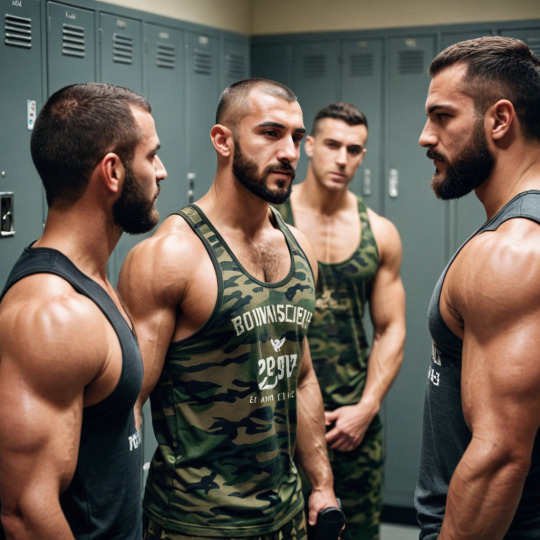
There is no better place than the gym. Hard training, hard fights, hard sex. Yes, sometimes you also have to bang a woman. So as not to get out of practice. And Swiss whores are easy to come by. You're all real guys who look and smell like men. The whores don't find anything like that among their fellow countrymen. But it's even better if one of your compatriots or an inferior Christian from the Balkans loses to you in a boxing match. The loser gets fucked. And you fuck a lot!
120 notes
·
View notes
Text
Writing Dialogue: Questions (pt. 2)
Alternative Questions
An alternative question gives a choice of two or more answers in the question and includes or:
Example: Would you like some ice cream or some cake?
Different types of alternative question
We can also ask alternative questions using or not? This is a very direct question and sometimes it can express annoyance or impatience:
Are you coming or not?
Do you want to go to the cinema or not?
Alternative questions can be answered as yes-no questions, depending on the context:
A: Are there trains or buses from the airport to Belgrade?
B: Yes, there are. (There are both trains and buses.)
(or There’s a train./There’s a bus.)
Alternative questions can be wh-questions:
Which do you prefer, with or without salt?
Which is best, to water the plant every day or just once a week?
Reduced alternative questions
Sometimes in informal speaking, we make alternative questions shorter by just saying the alternatives:
A: Would you like a coffee? B: That’d be great. A: Black or white? B: Black, please.
A: Are you renting an apartment in London? B: Yeah, very near Paddington Station. A: Sharing or on your own? B: I’m sharing with some old friends.
Statement Questions
We can use statements (declaratives) to ask yes-no questions.
In writing we know they are questions because they have question marks.
In speaking we know they are questions because of the context, and often because of their intonation:
Question form: Is that your father? Statement as question: That’s your father?
Question form: Do we pay at the end? Statement as question: We pay at the end?
The intonation of a statement question depends on its meaning.
We use statement questions when we think we know the answer to the question and we want to find out if we’re right:
Rising intonation: You went to Northbridge High School? (I think you went to Northbridge High School but I am not sure.) Falling intonation: You went to Northbridge High School? (I am very sure that you went to Northbridge High School.)
We can also use statement questions to express surprise.
When we express surprise, we use rising intonation.
A: I’ve made a coffee cake. B: That’s a coffee cake? (with rising intonation)
A: Friday is Kyle’s last day at work. B: Kyle’s leaving? (with rising intonation)
Two-Step Questions
In speaking, we sometimes ask two questions together.
The first question is just an introduction for the listener.
We use these especially when we don’t want to be too direct:
[1] What do you think about this building? [2] I mean, do you like it?
(The first question introduces the topic of the building, the second one asks a more specific question about it. The listener answers the second question.)
[1] Do you miss home? [2] Like, do you miss your mother’s cooking?
(The first question introduces the topic of missing home, the second one asks a more specific question about it. The listener answers the second question.)
Two-step yes-no questions
We sometimes use yes-no questions one after the other.
The first question is an introduction to the topic and the speaker usually knows the answer.
The second question is more specific.
A: Are you driving to college tomorrow? B: Yeah. I’m hoping to leave at 8 am. A: Could I have a lift with you?
The first question is introductory. A knows that B usually drives to college. The second question is more specific. By asking the question in two stages, the speaker is being less direct with the listener.
A: Could I have a lift with you if you are driving to college? B: Yeah sure. I’m hoping to leave at 8 am.
A asks B for a lift to college all in one question. This is correct too, but it is slightly more direct.
Pre-questions in two-step questions
Sometimes we ask if we can ask a question.
This is very polite:
A: Do you mind if I ask you a personal question? B: Sure. A: Do you like Janie? B: Well, most of the time, I do.
In formal contexts, such as interviews, we commonly use these polite pre-questions before we ask the main question:
Example: May I ask you a question about your last job? Why did you leave it?
We can add just and please to make them even more polite:
Polite: Can I ask a question? More polite: Can I just ask a question, please?
pt. 1
#writing notes#writing refresher#writeblr#writers on tumblr#spilled ink#dark academia#light academia#grammar#linguistics#langblr#writing prompt#poetry#poets on tumblr#literature#words#lit#creative writing#dialogue#character development#writing reference#writing resources
46 notes
·
View notes
Text
Carlo Rovelli
In 1999, NATO bombed Belgrade for 78 days with the goal of breaking Serbia apart and giving rise to an independent Kosovo, now home to a major NATO base in the Balkans.
In 2001, the US invaded Afghanistan, leading to 200,000 people killed, a country devastated and no political result whatsoever.
In 2002, the US unilaterally withdrew from the Anti-Ballistic Missile Treaty over Russia’s strenuous objections, dramatically increasing the nuclear risk.
In 2003, the US and NATO allies repudiated the UN Security Council by going to war in Iraq on false pretenses. Iraq is now devastated, no real political pacification has been achieved and the elected parliament has a pro-Iran majority.
In 2004, betraying engagements, the US continued with NATO enlargement, this time to the Baltic States and countries in the Black Sea region (Bulgaria and Romania) and the Balkans.
In 2008, over Russia’s urgent and strenuous objections, the US pledged to expand NATO to Georgia and Ukraine. �
In 2011, the US tasked the CIA to overthrow Syria’s Bashar al-Assad, an ally of Russia. Syria is devastated by war. No political gain achieved for the US.
In 2011, NATO bombed Libya in order to overthrow Moammar Qaddafi. The country, that was prosperous, peaceful, and stable, is now devastated, in civil war, in ruin.
In 2014, the US conspired with Ukrainian nationalist forces to overthrow Ukraine’s President Viktor Yanukovych. The country is now in a bitter war.
In 2015, the US began to place Aegis anti-ballistic missiles in Eastern Europe (Romania), a short distance from Russia.
In 2016-2020, the US supported Ukraine in undermining the Minsk II agreement, despite its unanimous backing by the UN Security Council. The country is now in a bitter war.
In 2021, the new Biden Administration refused to negotiate with Russia over the question of NATO enlargement to Ukraine, prompting the invasion.
In April 2022, the US called on Ukraine to withdraw from peace negotiations with Russia. The result is the useless prolongation of war, with more territory gained by Russia.
After the fall of the Soviet Union, the US sought and until today is seeking, without succeeding, and constantly failing, a unipolar world led by a hegemonic US, in which Russia, China, Iran and other great nations have to be subservient.
In this US-led world order (this is the phrase commonly used in the US), the US and the US alone has determine the utilization of the dollar-based banking system, the placement of overseas US military bases, the extent of NATO membership, and the deployment of US missile systems, without any veto or say by other countries.
This arrogant foreign policy has led to constant war, countries devastated, millions killed, a widening rupture of relations between the US-led bloc of nations -a small minority in the planet and now not even anymore economically dominating- and the rest of the world, a global skyrocketing of military expenses, and is slowly leading us towards WWIII.
The wise, decade-long, European effort to engage Russia and China into a strategical economical and political collaboration, enthusiastically supported by the Russian and Chinese leadership, has been shattered by the ferocious US opposition, worried that this could have undermined the US dominance.
Is this the world we want?
23 notes
·
View notes
Text
Tens of thousands of people streamed into a central square in Serbia's capital on Sunday for a rally against populist President Aleksandar Vucic and his government, whose tight grip on power has been challenged by weeks of street protests led by university students.
The rally at Belgrade's Slavija Square, one of the largest in recent years, was called by students and farmer unions. It was part of a wider movement demanding accountability over the Nov. 1 collapse of a canopy at a railway station in the country's north that killed 15 people.
“We are all under the canopy,” read one of the banners displayed at the main Belgrade square.
Smaller rallies were also held in the cities of Nis and Kragujevac. The protest in Belgrade started with a 15-minute silence for the victims, and later chants of “You have blood on your hands!” were heard.
Many in Serbia blame the collapse on widespread corruption and sloppy work on the railway station building in the city of Novi Sad that was twice renovated in recent years as part of questionable mega projects involving Chinese state companies. Protesters demand that Vucic and those responsible face justice.
Read moreSerbia: Anti-corruption movement gains ground after deadly train station accident
Serbia's popular theater and movie actors joined the protest, with actor Bane Trifunovic describing Sunday’s rally as “a festival of freedom.”
In a show of confidence, the Serbian president on Sunday inaugurated a section of a newly built highway in central Serbia. Vucic said he wouldn't budge to opposition demands for a transitional government and accused his opponents of using students to try to seize power.
“We will beat them again,” said Vucic.“They (the opposition) don't know what to do but to use someone's children.”
In an apparent attempt to defuse the student-led protests, Vucic has been advertising what he said are “favorable” loans for young people to purchase apartments as well as attracting tens of thousands of doctors and other skilled people who have left the Balkan country for a better life in the West in recent years.
Prosecutors have arrested 13 people over the Novi Sad tragedy, including a government minister whose release later fueled public skepticism about the honesty of the investigation.
The weekslong protests reflect wider discontent with Vucic's rule. The populist leader formally says he wants to take Serbia into the European Union but has faced accusations of curbing democratic freedoms rather than advancing them.
Opposition parties have said a transitional government that would prepare a free and fair election could be a way out of the political tensions as ruling populists also have been accused of rigging past votes.
Serbia’s government has extended school winter holidays by starting them nearly a week earlier to grapple with widening student protests.
Classes at universities throughout the Balkan country have been suspended for weeks with students camping inside their faculty buildings. In recent days, more high school students have joined the movement. Occasional violence has erupted when pro-government thugs tried to disrupt the protests.
A group of farmers said Sunday that police took away the tractor which they drove into central Belgrade ahead of the protest. In addition to the farmers, Serbia’s students also have received nationwide support from all walks of life including their professors, media personalities, lawyers and prominent individuals.
Vucic initially accused the students of launching protests for money but later said he has fulfilled their demands, including publishing documentation relating to the renovation work at the Novi Sad station.
(AP)
7 notes
·
View notes
Text
Košutnjak-Golf-Petosoban
Izdaje se petosoban stan na Košutnjaku-Golf
Banovo brdo, Golf, Petra Martinovića, petosoban, 171 kvm korisne površine, sa dve prostrane kružne lođe i otvorenim pogledom , 4/5st, cg, dva ulaza, dva mokra čvora,lift, ugradna kuhinja. Stan je pogodan i za poslovni prostor. Izdaje se nenamešten na duži vremenski period uz jedan depozit. Cena zakupa je 1600 eur. Foto Galerija – Slideshow Izdavanje vodi Boris Čoko, lic.br.113, mob.tel.…

View On WordPress
#apartment belgrade#apartment-for-rent#apartments for rent#banovo brdo#golf#izdavanje stanova beograd#košutnjak#nekretnine#petosoban#stanovi beograd#čukarica
0 notes
Text
I know I'm a nerd because the amount of time I've spent obsessing over the Vojvodina dress is. Way too much.
This dress doesn't actually have a name (probably), but it's from late 19th century Vojvodina, and I kind of obsessed over it when I was at the Serbian Ethnographic Museum in Belgrade (main site is available only in Serbian).
(Unfortunately, I'm trying to work within the tumblr image limit, but here's a google drive!)
BTW, if you enjoy this post, please consider leaving a tip! I spent more time than is reasonable putting this together.
Also, due to tumblr being Odd, you may want to open this in a new tab to avoid having the posts expand to full; the dashboard view only lets there be one image per line, for some reason. If you open in a new tab, they are much more neatly organized into sets, and quicker to scroll past.
Due to the fact that I can't really describe these photos in a way that means anything to readers unless they have a large technical vocabulary or background in Balkan fashion history, and there being so many pictures, I will not be including image descriptions. However, my commentary on those photos throughout the latter half of the post should hopefully give you a solid summary on what the photos contain, even if it's not going into details for most.
Here is the general shape of what you see in 19th century Serbia (incl. Kosovo), Montenegro, Bosnia&Herzegovina, and Croatia:
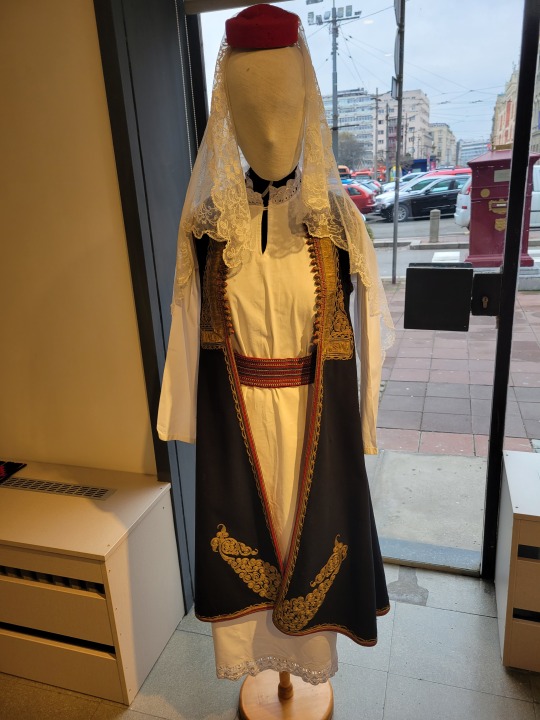

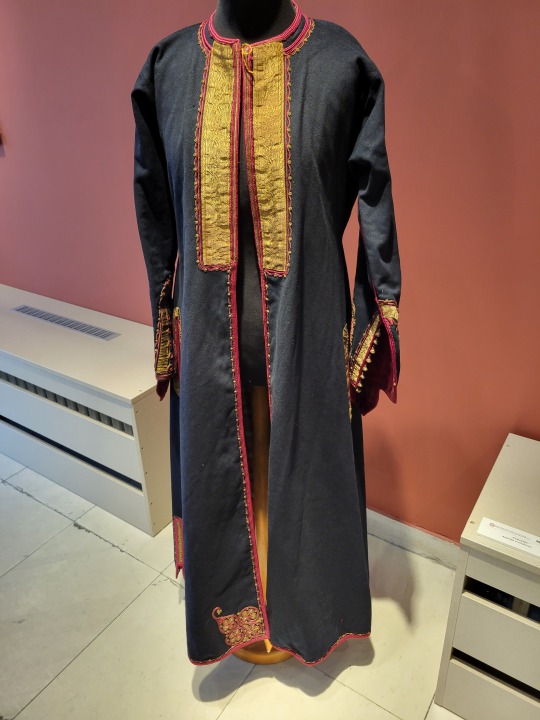

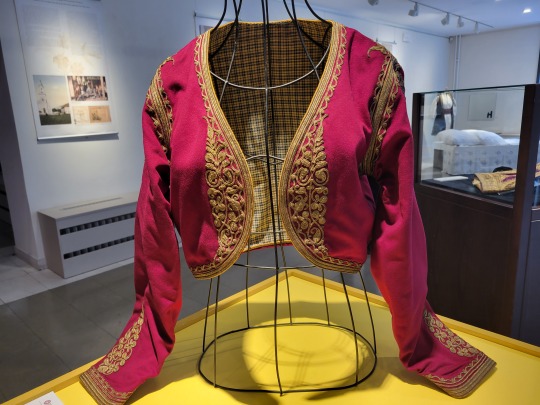
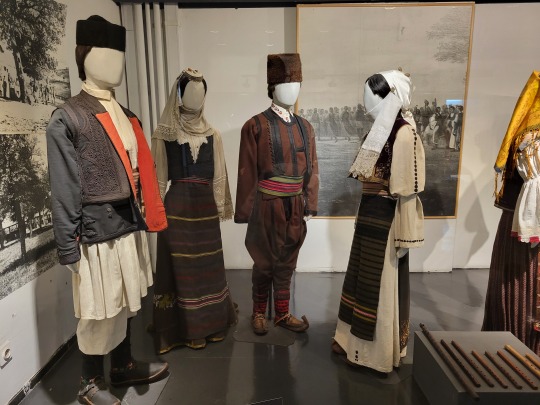
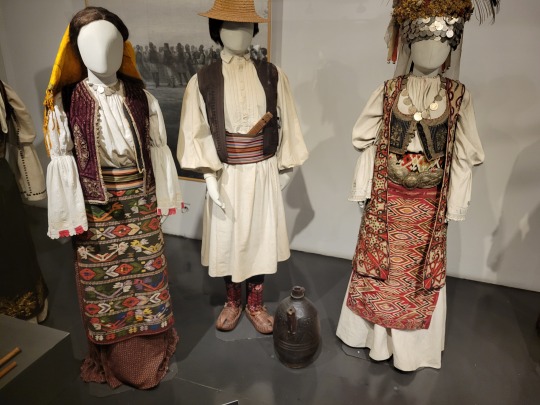


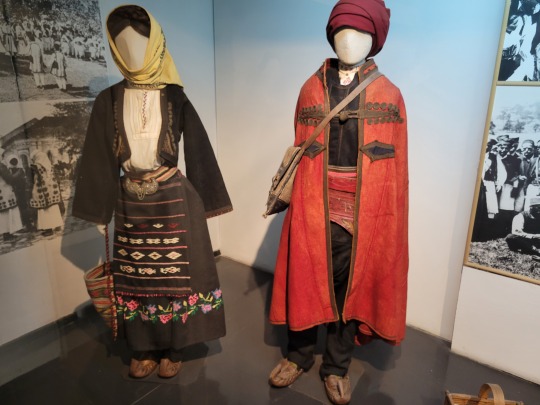

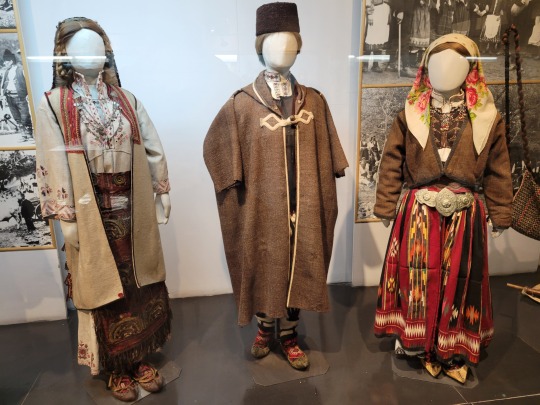

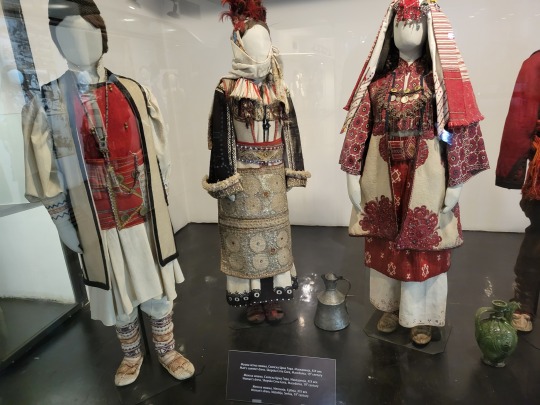


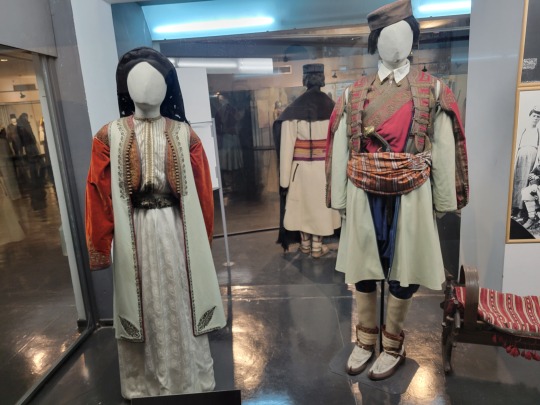
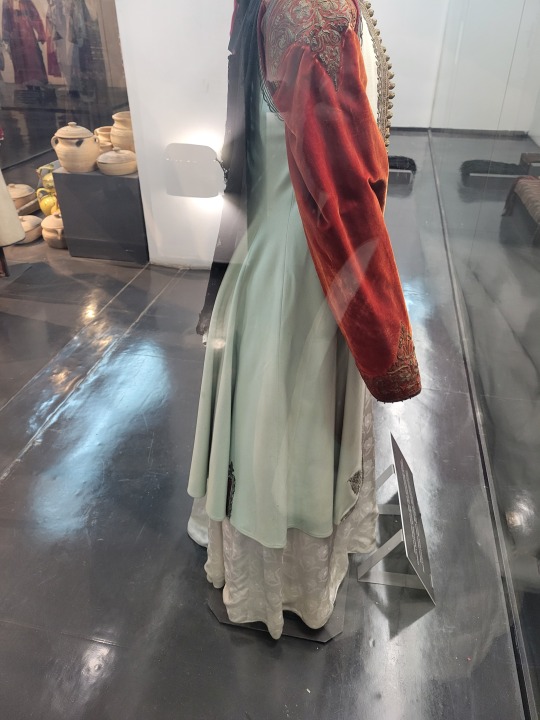
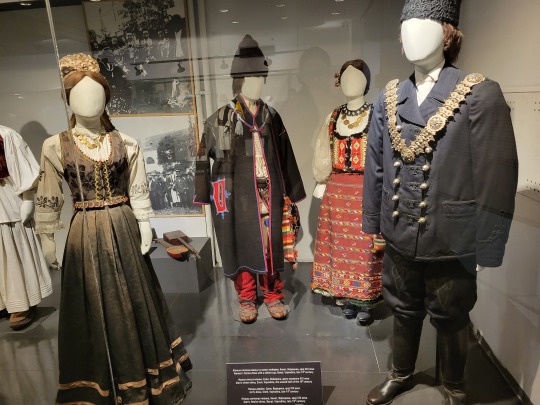
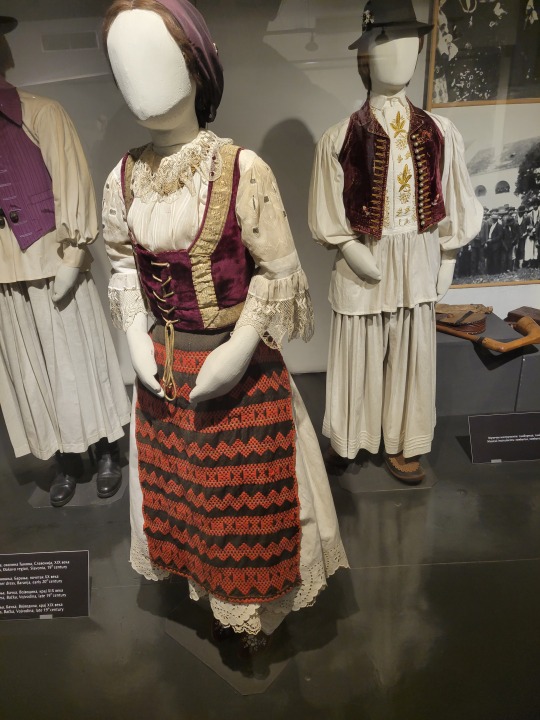
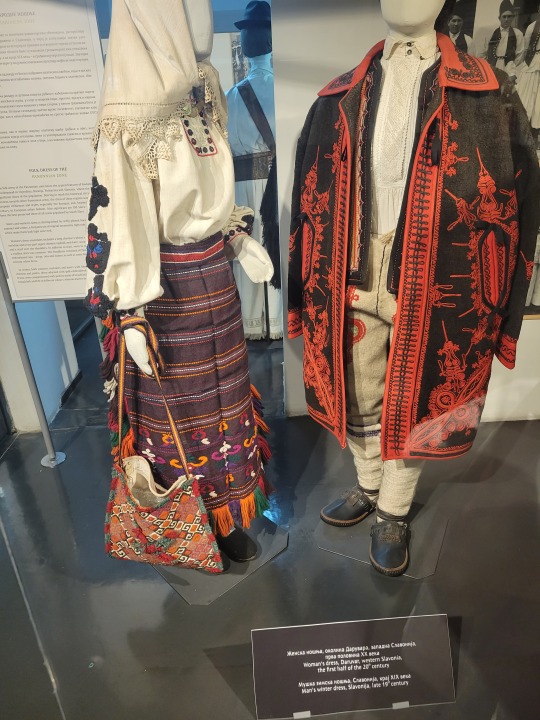
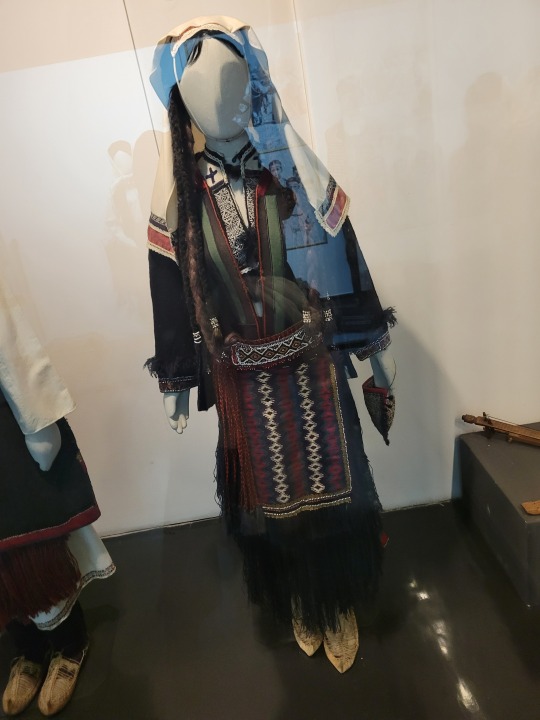
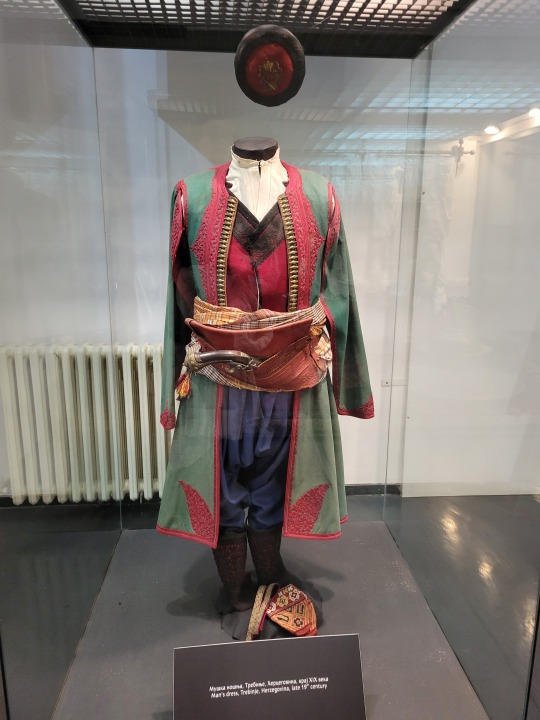

You can see a few throughlines, even with the variety from one region to the next. Certain types of fabric are more common, especially that heavy plain-weave white fiber (I think usually cotton, nowadays, but probably historically flax) with the small knots; my grandmother's apartment is still stocked with that as the default bed linen! You see it all through the exhibit, most frequently in the skirts, but often for blouses or chemises, too.
There are a lot of hand-woven fabrics, which you can see on display best with the aprons, and a very specific style of applique trimmings on the cropped vest. The arm's eyes and necklines have similar proportions. The lengths are similar. Most things are cut on the rectangular, or not cut at all. Hems are often tassled, for complex weaves, or simply folded under for the white base fabrics; plain, non-white fabrics tend to get a textured applique at the hems. Lace is usually eyelet.
There are exceptions, of course. I'd love to know more about that mint green cardigan(?) from Montenegro, with the gored pieces. I think it's made of doeskin (the tight wool weave, not the leather), and I wish I could get more information on the history. Most of the larger green dyes, not counting floral motifs or minor elements of a multicolored weave, are from the Bosnian section of the display (wide stripes along the collar, for instance), presumably due to Ottoman influence leaving a large Muslim population. And then there's this mint green cardigan from Montenegro made of a fabric I'm not seeing on any other garments? Tell me more, please.
(Also, in the close-ups, you can see that the hook and eye closure has released rust stains onto the blouse!)
There are so many more pictures, but unfortunately, I have a thirty-image max and really want to talk about this one specific dress:
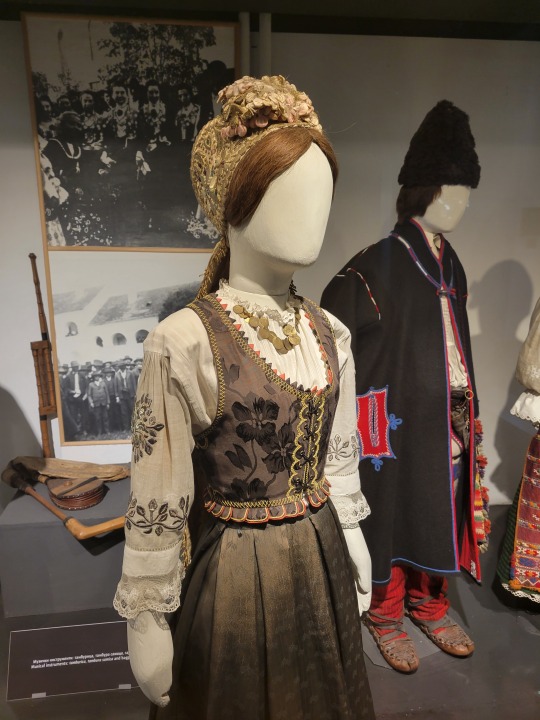
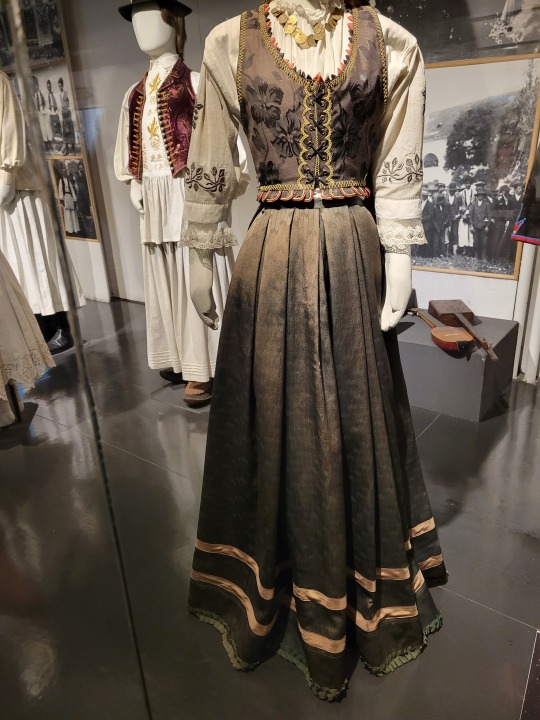
The image description on the floor below describes this as:
Woman's festive dress with a zlatara cap, Banat, Vojvodina, late 19th century
(I have minimal commentary on the hat. It's a traditionally Serbian vestment, but there's nothing too unusual about it.)
So, here are a few things to note at first glance:
The arm's eye on the vest is wide. It dips further in towards the neck than most vests, and swoops further down towards the ribs. Most of the traditional vests have a much tighter arm's eye.
Relatedly, the straps are much thinner than most of the vests, maybe half as wide. This is partly the arm's eye, and partly the width of the neckline to start!
The vest comes down in a slightly pointed oval ending at the swell of the bust, rather than curving back up or being a rounded shape a few inches higher. It's also finished with these little satin triangles?
The vest is laced at front, rather than hook and eye closure.
The bottom edge has tabs!
The hems on those tabs are chain stitched in yellow, and then the hem is wrapped in a thin orange ribbon that I would hesitantly say is satin? Plus all the other yellow embroidery, which to my eye looks really different from the embroidery you see on various aprons, and also different from the metallic appliques you see on most vests!
That bottom edge also appears to be straight across (most of the vests curve up slightly at front), and is very tight to the body. While some of the vests are tight, those are generally the shorter ones. Longer vests are much looser than this one, which cuts off and cinches at the waist, right where it meets the skirt.
The fabric itself! I'll get back to this but it seems to be a satin jacquard??? A jacquard that matches (in thread, not in pattern) to the skirt? Insane.
[Disclaimer: Some of these deviations, such as the arm's eye size or the dropped shoulder hem, could be a matter of the mannequin being the wrong size for the clothing. Unfortunately, I don't have enough background information to be sure. It could be just the right size. It could be far too small. I only have these photos and the most basic of background information to go off of.]
Okay moving on to the blouse:
It's not completely unique to be sheer, but it's definitely uncommon!
The chest is not pintucked or a flat weave, but rather the sheer fabric has thin stripes of more opaque weave? I don't actually remember what that's called but it's definitely cool to see.
We also see a net lace at the cuffs, which is similarly uncommon; most of the fashions I saw had eyelet lace instead (which we can see at the collar of the blouse).
The dropped shoulder! The shoulder seam sits much higher on most of the pieces I saw (there are a few exceptions, but mostly from regions nearby). In fact, most of the examples had the shoulder seam hidden, between the higher seam and the width of the vest; it's both the dropped seam and the thin straps of the vest that let us see this here!
That metallic embroidery. Again, most of the embroidery we see on the other pieces is cross stitch or done with a much thicker thread; sometimes, you get lineart, but not filled in in this manner. This kind of thin-thread embroidery that fills the space between the lines isn't common in the other pieces!
I don't think I can actually say much about the sleeve length? I feel like most of the pieces have sleeves that are full or bracelet length, while this one is a three-quarter, but I'm not 100% on that actually being true. It's a bit hard to tell in some cases. Might just be summer clothes?
The skirt:
SATIN JACQUARD
BOX PLEATS
SLIGHT OVAL HEM
SATIN RIBBON TRIM
I'm gonna be honest this was a huge part of why I began to obsess over this dress let me just. Whoo!
This fabric is, as far as I can tell, a satin jacquard, very probably machine-woven. It is very different from basically every other fabric we see in this exhibit. This is not a plain weave, and it is not a hand-woven design. This is a meticulously, mechanically repetitive pattern done using satin-weave manipulation to adjust which sections have shine and which don't. Given the time period, it's probably silk. (Take a look at this portion of a video on silk by Nicole Rudolph to understand what I mean by jacquard. If you want to know more about satin weave, you can watch the full video.)
I'd guess that the vest is made of the same type of fabric, even the same threads, just in a different pattern.
The pleating! If you take a look at the other photos, the general pattern is 'put together some rectangles, gather at top, and you have a dress. Cover with a hand-woven apron in front and possibly in back.' There are, again, some exceptions, but this dress has both the box pleating and the satin jacquard. The structure of this skirt is completely different from 90% of this exhibit.
In conjunction with the pleating, the skirt had a very slight oval shape around the bottom. I didn't get a good photo of that part, but it's typical of 1890s dresses in Western Europe to have a sort of egg-shaped hem if you look at them from above, through use of pleating, strategic panel shapes, and bum pads or petticoats. In short, the dress is just slightly longer at back without being a full-on train. Most of the other pieces, due to the rectangles and gathers, are a much simpler circle shape around bottom.
Length! Part of why the egg-shaped hem is happening is because this dress actually brushes the floor. Ankle-length is the default across the exhibit, even for formal wear.
Simple satin ribbons for decorative trim, rather than something textured, shaped, or multicolor!
Then, the actual hem of the skirt: a center-pleated green ribbon. This is, again, really different from most of the hems. Most of the skirts don't reach the ground, and aren't made of a fancy fabric. Those white dresses/skirts that form the base of most looks are easily washed and have hems that don't drag on the ground. If they aren't left to just the selvage, they're very simply hemmed; I think what I saw most frequently was a double-folded hem. The pieces that have more decorative hems, like blouses and vests and aprons, aren't pieces that get the same form of wear. However, since this dress does reach the ground, it needs a centimeter or so of additional fabric to take some of that wear to protect the fancier skirt fabric, like hem braid, which the easily-replaced ribbon could conceal for this skirt since it's a festival item.
I think that might also be part of why there's a seam about twenty centimeters up from the bottom edge; it's a replaceable section in case it needs replacement, or the seam is for a protective layer inside. However, it could also be a seam used for a stiff inner lining meant to help the skirt flare out just a touch, like this.
Now, finally, why is all this even a thing, and why do I care?
Vojvodina, the region this outfit is from, was under Austro-Hungarian control during the latter half of the 19th century; whether it was officially Hungarian, Austrian, or both changed from one decade to the next, but it was definitely under that sphere of influence for a very long time. Despite this, it was and is culturally Serbian, and is majority Serbian in terms of population; it was even back then! However, the 19th century saw a large number of ethnic Hungarians and ethnic Germans in the region as well, and the cultural impact from Vienna was not to be underestimated.
This dress is a great example of how a culturally Serbian individual would have clothing that integrated those foreign influences. For most of the Balkans, the greatest influence was the Ottomans, due to five centuries of imperial rule, but this dress is a great contrast due to Hungarian occupation, and then Austrian. It contains elements of the culture that birthed it, yes, but the influence of the West is so very, very clear.
(I wish I could talk more about the Pannonian elements in general, but I'm still learning.)
I hope you enjoyed this rambling deep dive into a single outfit from the Serbian Ethnographic Museum. Visit it if you get a chance!
And if you've read this whole thing and feel like dropping a tip, you can do so on this blog, post, or over on ko-fi. You could even join my Patreon!
#serbia#vojvodina#fashion#fashion history#the vojvodina dress#serbian stuff#balkan stuff#balkans#Banat#Hungary#Austria Hungary#austro hungarian empire#phoenix posts
180 notes
·
View notes
Text
Opulence Estate offer Luxury Vacation Rentals in Belgrade & Providenciales
Opulence Estate facilitates beautiful vacation rental apartment right in the heart of city well connected with tourist sites; Knez Mihajlova Street, Belgrade. By being in the heart of events, night life, theater, clubs and restaurants, this contemporary luxury vacation apartment Belgrade provides complete tranquility while resting. The well-furnished vacation apartment is great place to relax after long day of searching leading venues like National theatre, best Belgrade restaurants and clubs, most significant cultural and historical complex of the Serbian capital Kalemegdan fortress. Unwind the historical Belgrade Fortress in proximity with Opulence Estate. To explore the attractions and recreational round the clock taxi service is available at doorsteps.
In Turks and Caicos, Providenciales is home to some of the most luxurious vacation rentals facilitating world class space for blissful vacationing. From luxury vacation villa to private beach house to oceanfront condos to resorts nestled amidst lush gardens, there are luxury accommodation options for every traveler's preferences and budget with Opulence Estate. A 3 bedroom vacation villa Providenciales with private access to the turquoise waters is the epitome of a tropical escape. The Caribbean Island, Providenciales is a world renowned tropical destination that cater visitor with pristine beaches, barrier reef system, abundance of marine life, and top notch outdoor recreational activities. Grace Bay Beach, regularly voted as one of the best beaches globally, boasts powdery white sands and translucent turquoise waters. The beautiful stretch of coastline offers a tranquil haven for sunbathing, swimming, snorkeling, and water sports. Whether, you are looking to relax under swaying palm trees or dive into vibrant barrier reefs, the beaches of Providenciales are a haven for beach lovers and water enthusiasts alike.
These TCI vacation rentals with Opulence Estate are centrally nestled so that travelers can explore maximum of what these Caribbean Islands offers. Take a trip to Chalk Sound National Park, a mesmerizing lagoon dotted with tiny cays and vibrant turquoise water. Explore the mysterious underground limestone caves at the Conch Bar Caves National Park, where you can witness unique stalactite and stalagmite formations. For bird enthusiasts, a visit to the bird sanctuary on Little Water Cay is a must, where you can spot the endangered rock iguanas and various bird species in their natural habitat. Provo offers a tropical getaway like no other. With its pristine beaches, azure waters, abundant outdoor activities, luxurious resorts, delectable cuisine, and rich cultural experiences, this Caribbean gem has something for every type of traveler.
0 notes
Text


"Justice for Noa Milivojev / Trans Revolution"
Graffiti in the sniper tower in Mostar, Bosnia in memory of Noa Milivojev, a trans woman who was murdered in Serbia last week. Her body was found cut up in several bags in Belgrade on July 6. A memorial was made for her, but it was trashed by nationalists and the trans flags torn apart.
245 notes
·
View notes
Note
also on the subject of the balkans/yugoslav wars - despite my sympathy for the bosnian people it seems like alija izetbegović might have been kind of a fucking moron. curious if you have any takes on this
Only minorly so, though I plead I know less of Bosnio than Kosovo. In the end everyone breaking apart Yugoslavia was dumb, they would have all been better off as a democratic confederation. But that is a coordination problem - if the Croats and Serbs are being dumbass nationalists, then you kind of need to be one as well in order to not be on the losing end of things? So Alija's actions like abandoning the Zulfikarpašić–Karadžić agreement with the Serbs was "bad" in a certain sense, but in other sense Croatia was already up in arms and the government in Belgrade was radicalizing and fighting back against demands for local autonomy. He is one of the cast of dozens who put petty historical grievances over a functioning socio-economic order for the benefit of the citizenry, but by no means the biggest one.
7 notes
·
View notes